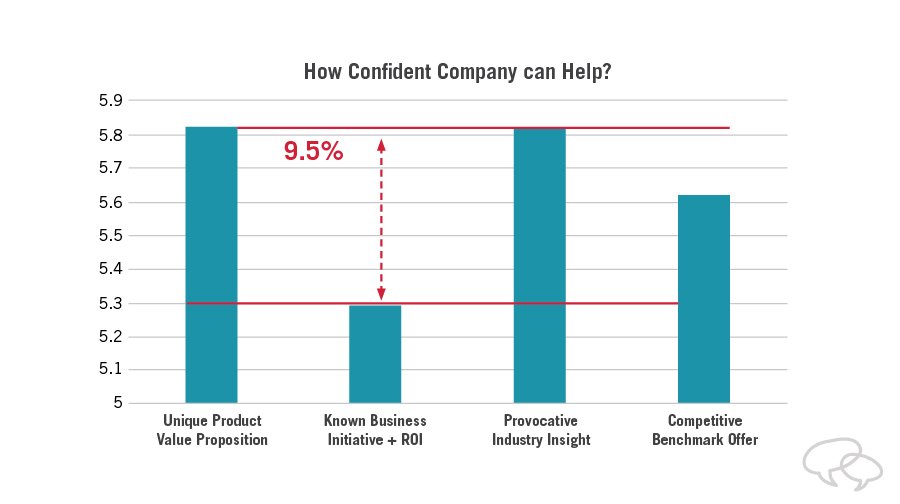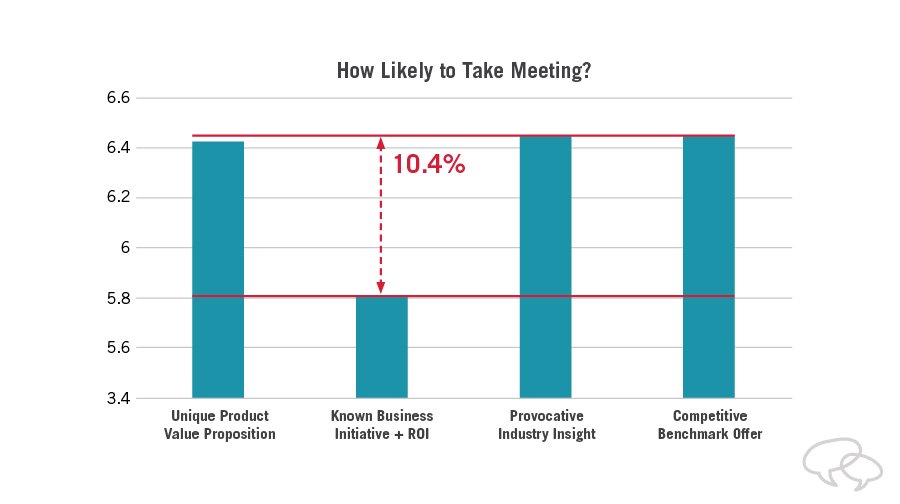
The most popular approach to executive-level selling is the least effective, according to behavioral research from Emblaze and Corporate Visions.
Conventional wisdom about executive selling says that if you want to talk with an executive, you need to talk like an executive. You need to offer up relevant case studies, ROI calculations, and quantified strategic results as the price of entry.
But that advice is over two decades old—popularized at a time when you had limited access to executive decision-makers and almost always had to finesse your way around the gatekeeper.
Sellers today have multiple, more direct paths to C-suite selling, yet getting through that boardroom door is harder than ever. And if your sales message doesn’t resonate with that busy executive, they’ll brush it aside without a second thought.
So, what messaging approach works best for executive-level selling? That’s what we set out to learn in this behavioral research study.
The Research: Gaining Access to Executive Buyers
To test the best sales approach to reach senior executives, we partnered with Dr. Nick Lee, Professor of Marketing at Warwick Business School, to look at the best executive selling approach a sales rep can use to get access to an executive and secure time on their calendar.
In this simulation-based test scenario, we recruited over 400 C-level executives with VP or higher titles in companies larger than $50 million, across multiple industries, who had authority over budget and purchasing decisions.
The executives were told they were reading an email from an outside vendor sales rep they didn’t know and had never met with before. They were then randomly divided into four test messaging conditions. After reading the message, they answered a series of questions, including whether they would take a meeting, decline, or delegate.
The Four Sales Message Test Conditions
These four test messages represent a “best of breed” example for executive selling. They’ve all been recommended and used with noted success in various messaging environments for 20 years or more.
Unique Product Value Proposition: This approach uses a proven model for creating and delivering a differentiated product value proposition that shows how the seller’s solution helps solve a problem in a new, different, or better way than competitive alternatives.
Known Business Initiative + ROI: This is a popular approach that’s been widely promoted for the last 20 years across a variety of sales training programs. It’s where the seller demonstrates they’ve done their homework and understands the priorities or challenges that the executive is trying to address. Then, they share quantified ROI results from other similar customers and offers an estimated potential impact on the executive’s business.
Provocative Industry Insight: This approach introduces a new need the executive hasn’t considered up to this point, based on the seller’s experience with other customers. This “Unconsidered Need” may be a problem or missed opportunity the executive doesn’t know they have or doesn’t fully appreciate. This is an approach we’ve tested and shown to work in other sales conversations, but had not yet tested specifically as an approach to gaining executive access.
Competitive Benchmark Offer: This approach has generated a lot of buzz recently. The seller offers to benchmark information comparing the prospective executive’s company to other similar companies. Ideally, it includes exclusive data your company developed with existing customers in relevant industries. This data offers executives a chance to see how they stack up across a range of key performance indicators.
Research into Executive-Level Selling Reveals a Clear Loser
The results of this study reveal a clear loser. The “Known Business Initiative + ROI” condition—the “VITO”-style approach promoted by so many sales processes and skills training companies for the last 20+ years—consistently finished last across the board.
In fact, the executives in the Known Business Initiative + ROI test condition:
- Viewed the vendor as nine percent less credible than did the participants in the other test conditions
- Were nine-and-a-half percent less confident in the vendor than were the participants in the other test conditions
- Were more than 10 percent less likely to take the meeting than the participants in the other test conditions
- Were 12 percent more likely to decline the meeting than the participants in the best-performing messaging conditions




Why Was Conventional Wisdom Wrong?
Why was the Known Business Initiative + ROI approach—a message advocated by so many training programs for executive-level selling—perform so poorly?
If you’re trying to get an executive’s attention and get on their calendar, you need to overcome what decision scientists call Preference Stability (one of the four causes of Status Quo Bias).
How do you de-stabilize a preference? Not by simply telling the executive that you can do what they’re asking. That will only reinforce their preference. You destabilize preferences by offering new information that they don’t know. Offering that new information either changes how they define the problem or changes the range of options they have available to solve it.
A Known Business Initiative is, by definition, already known to the executive, and offers no new information to de-stabilize preferences. So, it appears that you can’t defeat your executive prospects’ existing preferences with abstract speculation about ROI pertaining to a business need they’re already aware of.
Based on the research results, you can also eliminate the Unique Value Proposition message. Notice in the charts above those executives in the Unique Value Proposition test condition were equally willing to either accept or decline a meeting. Because the results aren’t consistent or reliable, we don’t recommend using it.
What’s the Best Approach for Executive-Level Selling?
Which approach is best for executive-level sales conversations? Prior research from Emblaze and Corporate Visions has the answer.
An earlier study, conducted with a nearly identical executive panel as this research, examined the messaging approach that persuaded executives to move forward with a proposal in a meeting. In that study, a message that introduced a provocative, Unconsidered Need was consistently the most effective approach.
We call this the Why Now story. Here’s a breakdown of each step in the Why Now message framework:
Present a business issue rooted in external trends and factors the executive will identify with and connect back to their strategic initiatives;
Introduce Unconsidered Needs—that is, unforeseen problems, challenges or missed opportunities your prospect has underappreciated or doesn’t yet know about that create flaws or limitations in his or her current approach;
Provide a solution story, demonstrating specifically how you can resolve the Unconsidered Needs you identified and enable them to realize their goals;
Quantify business impact by sharing a preliminary calculation of how your solution can positively influence revenues, cost savings, and operating margin.
The goal in your Why Now conversations are to generate enough curiosity that you elevate your value beyond what you’re selling, and into your conversation as a whole. If an executive perceives that you’ve delivered a valuable conversation, you’ll get them to take the desired next step toward a decision.
The Provocative Industry Insight message in this research is based on the Why Now approach.
Providing competitive benchmarking in your prospect’s industry is interesting, it is very difficult for many companies to develop meaningful data to make that a reality across various industries they serve. Also, while it’s good at raising their curiosity, we have no research to prove it is helpful in getting a deal across the line.
That’s where the Why Now message edges out the competition. Research has already proven that introducing provocative industry insights is an effective way to add urgency and value to your C-level conversations.
It’s a slightly different situation when you’re trying to convince an executive to take a meeting versus persuading them to buy now. But we believe that being consistent in how you get the meeting and then deliver the meeting is important for executive-level sales conversations.
For more details about this research, download our State of the Conversation Report, The Key to the C-Suite: Messaging for Executive Access.





